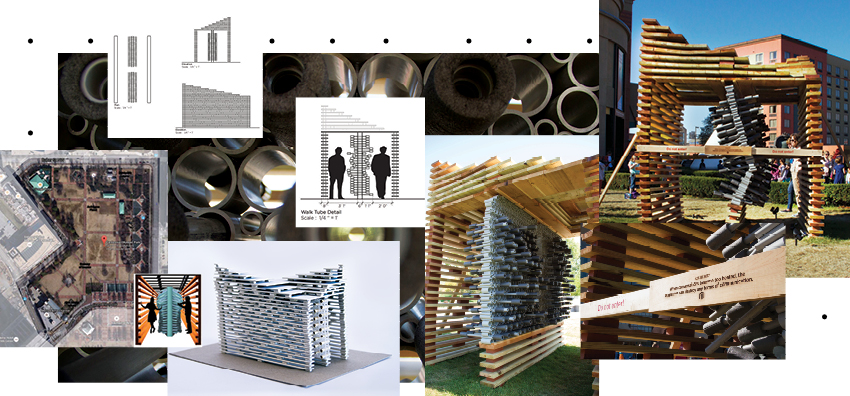
From the pages of Prattfolio, this article is part of a section highlighting the problem-solving process in the real world, from the perspective of alumni in the field. The Fall/Winter 2018 issue features the work of Nelly Bonilla, BArch ’10, and Oscar Luna, BFA Film ’10.
Nelly Bonilla and Oscar Luna teamed up after Pratt to form Home Eleven, an artistic partnership that uses installation works to spark dialogue and encourage understanding and compassion. With their Sticks and Stones Walk, taking its name from the familiar childhood rhyme, the artists aimed to create a space where viewers could experience how their words could have a physical effect on others, particularly in the type of anonymous, detached exchanges that happen on social media.
The idea: “There are two sides to every argument,” Bonilla and Luna say. During a disagreement of their own, the pair came up with a double-sided walkway as a visual depiction of the dispute. During the time it took to move through the space, two people could encounter a number of ways—represented by a movable center wall—to discuss or solve a problem.
The precedent: Luna and Bonilla found formal inspiration in “the Great Wall,” an exhibition space created by D’art Design Gruppe in Germany composed of cardboard tubes stacked to form a wall that visitors could manipulate to discover hidden contents. An installation by design collective Les Astronautes for Quebec’s public art event Les Passages Insolites (Unusual Passages) led them to consider the sensations of passing through a space narrowed by protrusions.
The plan: The artists conceived of a 10-foot-long enclosed walkway with a center wall filled with movable rods padded with pipe insulation. The sides of the structure would be made of wood planks separated by rocks or bricks to allow slivers of light through, creating the shadows of “sticks and stones.” The center section would start out even, giving the visitor on each side two feet of space, but “the moment someone forces their thought onto you, an imbalance happens.” At the halfway point, a window in the dividing wall would allow visitors a chance to break anonymity and consider their interlocutor.
The modification: With Hurricane Irma headed toward their Florida studio in the weeks before they were set to transport the installation to the ArtPrize exhibition in Grand Rapids, Michigan, last fall, the artists had to compress their production schedule and do without a plexiglass center wall, replacing it with variable-size PVC piping. “Ultimately, we felt it added to the aesthetic and language of the piece, illustrating that a strong division between two people can be an accumulation of small and big disagreements.”
The moment of truth: A week into the project’s exhibition, the artists received a call from the Grand Rapids Public Museum alerting them that their piece had been damaged—some guests had not observed museum etiquette, and the center wall gave way. “We came up with the idea of leaving the piece as is as a statement,” with a plaque adding a new layer of meaning to the piece. The closed walkway now represented a communication breakdown, but for the artists, another idea emerged: “A conversation should not defeat you.”
This article was originally published in Prattfolio (Fall/Winter 2018). Read the issue at www.pratt.edu/alumni.